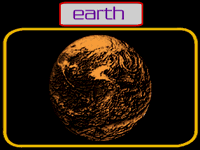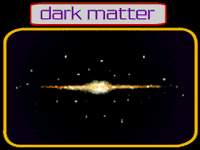- Objective:
To learn how much matter is in our universe.
- New Concept:
-
dark matter.
- New Terms used in this unit:
-
|
-
In the last unit, Big Chill or Big Crunch, we learned that the future of our universe depends on
its average mass density. If it is larger than the critical density, the universe will some day fall back in the
Big Crunch. If it is smaller than the critical density, it will end up in the Big Chill. Thus, the mass density is a
very important quantity for astronomers to measure.
|

Fig.1 The Big Chill end of the universe. If the universe contains too little matter, it will expand forever.
The stars will become dimmer and dimmer until their light is finally extinguished after exhausting their
nuclear fuel. The universe will thus end up a dead state with no light and no heat.
|
- Visible Matter
-
To estimate the mean density of visible matter, we can count all the galaxies and multiply this number by
their average mass. The average mass includes the stars, gases and dust floating in the galaxy. The
average mass density would then be the total mass divided by the volume occupied by the galaxies. In
other words:
average density of the visible matter = number of galaxies
* mean mass of the galaxies / the volume occupied by the galaxies.
Using this method, astronomers have found that the density of visible matter amounts only to a small
percent of the critical density. This means if visible matter is all we have, we will probably end up in a
deadly universe. However, our universe may contain a lot of matter which is invisible.
|

Fig.2 A spiral galaxy, presented here on edge, rotates faster than its visible mass can hold, indicating
that the galaxy is embedded in a halo of dark matter. The scale is arbitrary.
|
- Dark Matter
-
Some evidence suggests that the universe contains vast amounts of matter that is too dark to be seen.
Thus, it is dubbed as dark matter. Although dark matter does not emit or reflect light, it still
interacts with visible matter through gravitation. Dark matter may be responsible for changing the rotation
speed of a galaxy (see Fig. 2), bending light that passes by a lump of dark matter, and affecting the
formation of galaxies. These interactions reveal the existence of dark matter and enable astronomers to
estimate its density.
- The End of the Universe?
-
What could dark matter be? No one is sure yet. It could be very dim stars. If so, the total average mass
density of our universe could increase to about 20 per cent of the critical density. Dark matter could be
black holes. It could also be an exotic particle, which is
neither a proton, a neutron, nor an electron. These particles exist only in theory and have not yet been
discovered. Cosmologists like the idea of exotic particles, because it may help solve the problem of
galaxy formation (to be discussed in the next unit). If dark matter is indeed made up
of the exotic particles, then the mass density of the universe can be as high as the critical density, which
implies that 90 per cent of the mass in our universe will be dark matter. Since the nature of dark matter is
not certain, we still do not know how our universe will end.
|



